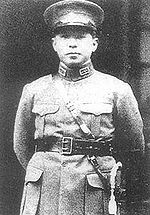
Chinese reunification (1928)
Encyclopedia


Zhang Xueliang
Zhang Xueliang or Chang Hsüeh-liang , occasionally called Peter Hsueh Liang Chang in English, nicknamed the Young Marshal , was the effective ruler of Manchuria and much of North China after the assassination of his father, Zhang Zuolin, by the Japanese on 4 June 1928...
's announcement on December 29, 1928 on replacing all banners of the Beiyang Government in Manchuria
Manchuria
Manchuria is a historical name given to a large geographic region in northeast Asia. Depending on the definition of its extent, Manchuria usually falls entirely within the People's Republic of China, or is sometimes divided between China and Russia. The region is commonly referred to as Northeast...
to the flag of the Nationalist Government
Flag of the Republic of China
The Flag of the Republic of China is red with a navy blue canton bearing a white sun with 12 triangular rays. In Chinese, the flag is commonly described as Blue Sky, White Sun, and a Wholly Red Earth to reflect its attributes....
, thus nominally uniting China under one state.
Origin
In April 1928, Chiang Kai-shekChiang Kai-shek
Chiang Kai-shek was a political and military leader of 20th century China. He is known as Jiǎng Jièshí or Jiǎng Zhōngzhèng in Mandarin....
was reinstated to the commander of the National Revolutionary Army
National Revolutionary Army
The National Revolutionary Army , pre-1928 sometimes shortened to 革命軍 or Revolutionary Army and between 1928-1947 as 國軍 or National Army was the Military Arm of the Kuomintang from 1925 until 1947, as well as the national army of the Republic of China during the KMT's period of party rule...
, the position he previous resigned to take responsibility for splitting the KMT during the First Northern Expedition. He proceeded with the Second Northern Expedition and was approaching Peking near the end of May. The Beiyang Government in Peking was forced to dissolve as a result, in which Zhang Zuolin
Zhang Zuolin
Zhang Zuolin was the warlord of Manchuria from 1916 to 1928 . He successfully invaded China proper in October 1924 in the Second Zhili-Fengtian War. He gained control of Peking, including China's internationally recognized government, in April 1926...
abandoned Peking to return to Manchuria, and was assassinated in the Huanggutun
Huanggutun Incident
Huanggutun Incident was an assassination plotted by the Japanese Kwantung Army that targeted Fengtian warlord Zhang Zuolin. It took place on June 4, 1928 at Huanggutun rail station near Shenyang in which Zhang's train was destroyed by an explosion...
by the Japanese Kwantung Army. Manchuria remained held by the Fengtian clique
Fengtian clique
The Fengtian Clique was one of several mutually hostile cliques or factions that split from the Beiyang Clique in the Republic of China's warlord era. It was named for Fengtian Province and led by Zhang Zuolin...
however, still hanging the banner of the Beiyang Government. The ultimate objective of the Northern Expedition was not fully accomplished.
Process

Zhang Xueliang
Zhang Xueliang or Chang Hsüeh-liang , occasionally called Peter Hsueh Liang Chang in English, nicknamed the Young Marshal , was the effective ruler of Manchuria and much of North China after the assassination of his father, Zhang Zuolin, by the Japanese on 4 June 1928...
returned to Shenyang to succeed his father's position. On July 1, Zhang Xueliang announced an armistice with the National Revolutionary Army
National Revolutionary Army
The National Revolutionary Army , pre-1928 sometimes shortened to 革命軍 or Revolutionary Army and between 1928-1947 as 國軍 or National Army was the Military Arm of the Kuomintang from 1925 until 1947, as well as the national army of the Republic of China during the KMT's period of party rule...
and proclaimed that he would not interfere with the re-unification. The Japanese were dissatisfied with the move and demanded Zhang carry out the independence of Manchuria. Zhang Xueliang denied the Japanese demand and proceeded on with unification matters. On July 3, Chiang Kai-shek arrived in Peking and met the representative from the Fengtian clique to discuss a peaceful settlement. This negotiation reflected the scramble between the United States and Japan on her sphere of influence in China because the United States supported Chiang Kai-shek unifying Manchuria. With the pressure from the United States and Britain, Japan was diplomatically isolated on this issue. On December 29, Zhang Xueliang announced the replacement of all flags in Manchuria and accepted the jurisdiction of the Nationalist Government. Two days later, the Nationalist Government appointed Zhang as the commander of the Northeast Army. China was symbolically reunified at this point.

